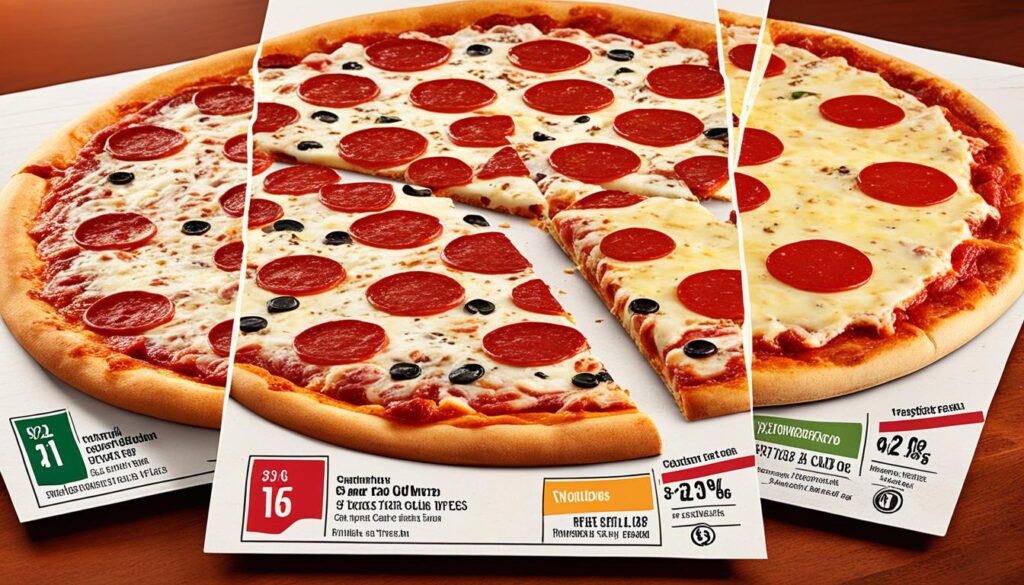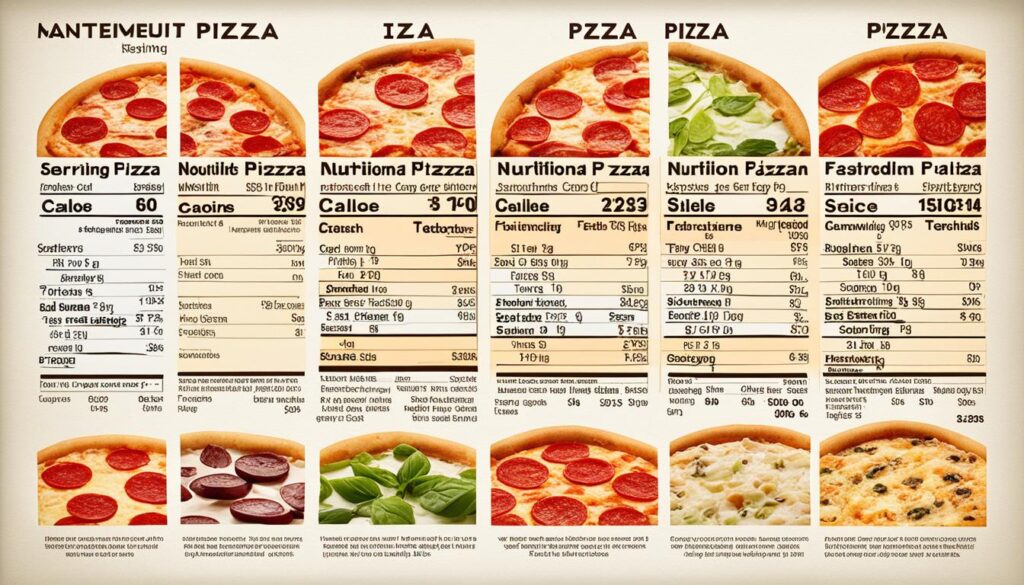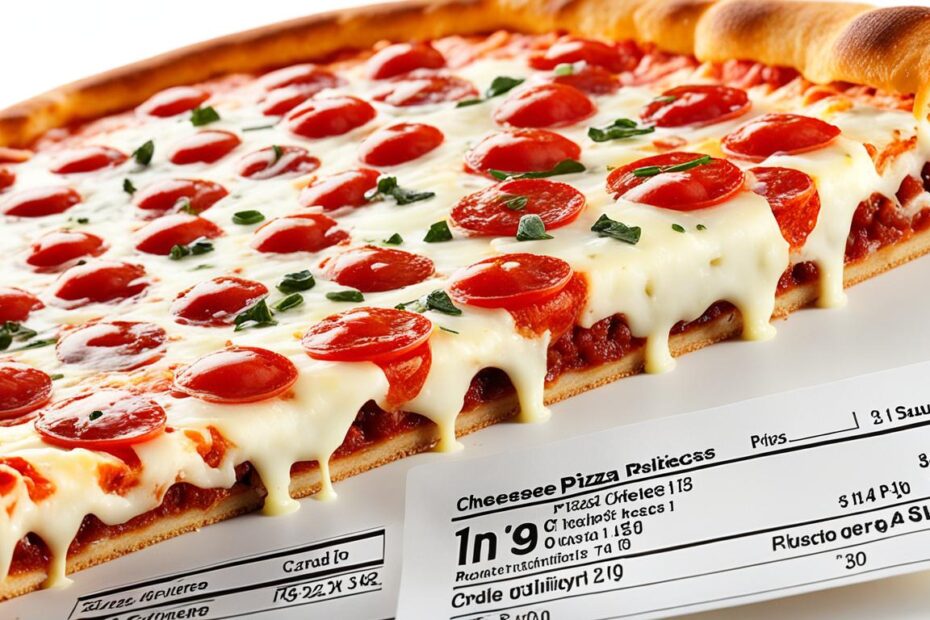Imagine this: It’s Friday night, and you and your friends are huddled on the couch, ready for a movie marathon. The aroma of freshly baked pizza wafts through the air. It makes your mouth water with anticipation. You reach for a slice, enjoying the gooey cheese and a burst of flavors. But have you wondered how many calories that slice has?
Pizza is tasty and easy to eat, but can be high in calories. The calorie count of pizza slices changes due to various factors. These include the toppings, crust type, and slice size. A typical cheese pizza slice has around 250-350 calories. Yet, this amount can go up if you add things like pepperoni or extra cheese.
Wanna know how toppings can change your pizza’s calorie count? Click here to learn more!
How Toppings Affect Calorie Content
The toppings you pick for your pizza really affect its calories. Every topping has a different calorie amount. For instance, pepperoni gives about 50 extra calories per slice. In contrast, mushrooms only add about 15 calories. Toppings such as sausage, bacon, and extra cheese also push up the calorie number.
Vegetables like onions, peppers, and spinach, though, are low-calorie. They also bring in good nutrients. Picking these healthier options and watching your portions lets you enjoy pizza without too many calories.
Managing Calorie Intake with Toppings
Choosing your pizza’s toppings can greatly change how many calories you eat. Go for veggies as they are low in calories and full of good stuff. Onions, peppers, and spinach are great examples of such toppings. They provide vitamins and minerals.
Additionally, adding lean proteins, like grilled chicken or turkey, boosts the pizza’s nutrition without a big calorie jump. Think carefully about your toppings. Going for the healthier choices makes your pizza both tasty and good for you.
Pizza Brands and Calorie Content
The calorie count of a pizza slice changes by brand. Brands differ in ingredients and how they cook, affecting calorie numbers.
A slice of Pizza Hut 14-inch cheese pizza has roughly 289 calories. On the other hand, a slice of Domino’s 14-inch cheese pizza has about 277 calories. Papa John’s 14-inch cheese pizza has around 304 calories per slice. Lastly, a Little Caesars’ slice is about 236 calories.
Always look at the nutritional chart from the pizza place. This helps you know exactly how many calories are in each slice.

Making Healthier Pizza Choices
Looking to eat healthier pizza? Start by choosing a thin-crust pizza. Thin crusts have fewer calories than thick crusts. This means each slice is lower in calories.
Next, think about what goes on your pizza. Pick veggies like tomatoes, onions, and spinach to keep it healthy. These toppings are low in calories but high in good stuff like vitamins and minerals.
Also, go for lean meats like chicken or turkey. They’re lower in bad fats and calories than sausage or pepperoni. Plus, they keep you full longer because of the protein.
It’s smart to watch your portion sizes too. Instead of several slices, have a smaller amount. You could also eat your pizza with a salad or some veggies. This turns it into a balanced and healthier meal.
Many pizza places now offer healthier choices. These pizzas have things like thin crusts, less cheese, and more veggies. They’re made to be lower in calories but still delicious.
“Choosing vegetable toppings and lean proteins like chicken or turkey can make your pizza healthier.”
“Controlling portion sizes and avoiding excessive amounts of high-calorie toppings can help you manage your calorie intake.”
“Opting for lighter pizza options or customizable pizzas can allow you to choose healthier ingredients.”
Nutritional Value of Pizza
Many think of pizza as junk food, but it can be nutritious. It all depends on how it’s made. Choosing a whole wheat crust boosts complex carbohydrates and fiber. This is good for lowering the risk of stroke and type 2 diabetes.
The toppings matter too. Add vegetables like peppers, spinach, and mushrooms for more vitamins and minerals. Cheese is full of calcium and protein. Lean meats like chicken or turkey add even more nutrition. So, by choosing wisely, pizza is part of a healthy diet.

Whole Wheat Crust for Added Nutrition
Whole wheat crust is a better choice than white flour. It’s full of fiber, good for digestion, and keeps you feeling full. The complex carbohydrates in it maintain steady blood sugar levels and provide lasting energy.
Healthy Toppings for Essential Nutrients
The toppings you pick are important for your pizza’s nutrition. Choose plenty of vegetables, such as peppers, spinach, and mushrooms. They add vitamins, minerals, and antioxidants for your health.
Protein from Cheese and Lean Meats
Cheese is a major protein source and is vital for tissue repair. Picking lower-fat options like mozzarella or feta helps cut calories. You can also go for chicken or turkey for more lean protein, supporting muscle health.
Pizza and Weight Management
Managing your weight means watching how much you eat. Even while keeping an eye on your diet, you can treat yourself to pizza. It’s all about being aware and not overdoing it.
To limit your pizza’s calories, plan how much you’ll eat before you start. Don’t eat the whole pizza at once. Slice it up into reasonable parts. This way, you watch your calorie count and avoid going overboard.
Being smart about the pizza you pick matters too. Choose thin crust because it has fewer calories than thick crust. Toppings like bell peppers, tomatoes, and mushrooms are low-calorie but rich in nutrients. Adding lean proteins like chicken or turkey can make your pizza healthier.
But pizza isn’t the only thing that matters. It’s also about staying active and having a varied diet. Eating pizza in moderation, as part of a balanced life, lets you enjoy it without guilt.
So, pizza can still be in your plan if you’re careful. Control your portions, choose healthy ingredients, and balance your meals. It’s about making choices that are right for you.
Conclusion
Pizza is both tasty and easy to grab, but it’s wise to watch the calories. The calories in one pizza slice can change based on what’s on it and how it’s made. Picking healthier toppings, smaller portions, and thin crusts help you eat smarter. Also, think about what’s in your pizza. Veggies and lean meats make it more nutritious. By making thoughtful choices and not overdoing it, pizza can be part of a healthy diet.
